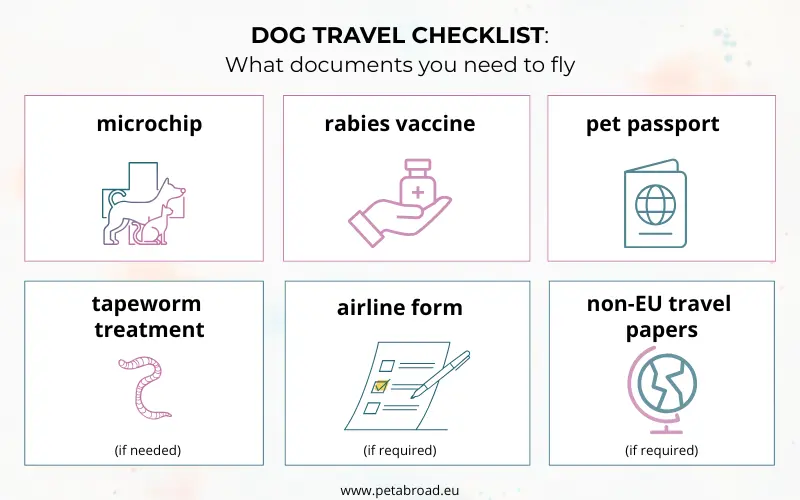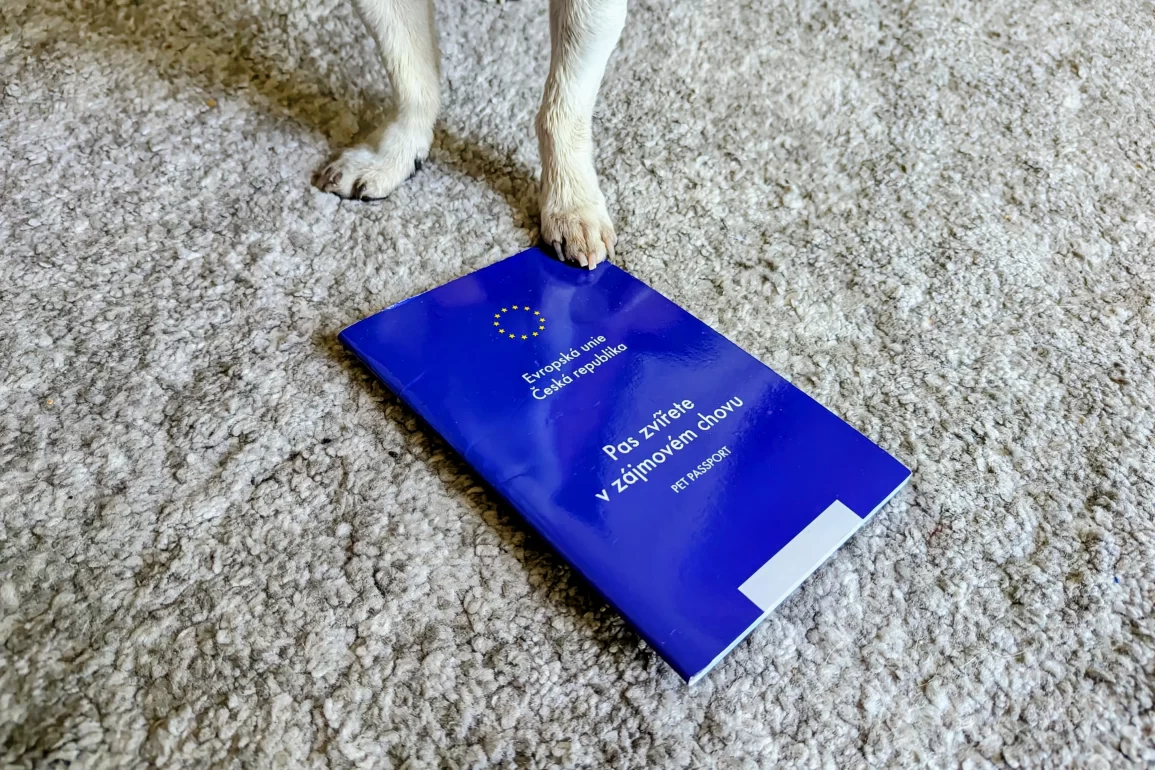Flying with a dog isn’t just about booking your flight and packing a few snacks. Whether you’re going to Rome, Reykjavík, or traveling further abroad, the paperwork really does matter. But no worries — we’ll walk you through it all, so you and your furry sidekick can focus on enjoying the trip.
Pet travel documents you need for a flight
Before flying with your dog or cat, make sure you’ve got all the right paperwork sorted ahead of time. What you’ll need depends on a few things — where you’re going, which airline you’re flying with, and whether your pet is traveling within the EU or beyond.
You’ll usually need an EU Pet Passport or a health certificate, proof of recent vaccinations, and maybe even a few extra forms from the airline. It’s easy to forget about this stuff until the last minute, but without it, they might actually not let you fly.
EU Pet passport: What it is and how to get it
The EU Pet Passport is the go-to document for travelling with your dog or cat across Europe. It includes your pet’s ID, microchip number, and proof of rabies vaccination — everything needed to meet EU rules. You’ll get it from an EU-authorised vet after your pet is microchipped and vaccinated.
In some cases, extra treatments like tapeworm prevention are required — e.g. when travelling to Finland, Ireland, or Malta. Also known as a dog passport or cat passport EU, this important booklet is your pet’s ticket to smooth border crossings in most EU countries, especially if traveling by plane.
🐾 — Official: Travelling with pets in the EU — ✈️
What’s required to get a pet passport
Getting a dog EU passport is actually quite easy. The non-negotiable requirements are valid rabies vaccinations and also make sure, that your pet is microchiped. This information, along with others, is listed in the animal passport itself.
Keep in mind, that the passport can only be issued by an EU-authorised veterinarian — typically during a single appointment where your vet checks your pet’s ID, vaccination status, and overall health. In some cases, tapeworm treatment may also be needed.
Once you obtain the dog passport, the document stays valid as long as rabies boosters are kept up to date but if you travel more often, it is possible that after some time you will run out of spaces for health checks, for example, in which case you should go to a veterinarian who will issue you a new passport.
Pet health certificate vs pet passport: What’s the difference
In short:
- EU pet passport = reusable travel document for EU-based pets
- EU Animal health certificate = single-use entry document for pets coming from outside the EU
Explained:
The EU Pet Passport is a permanent document issued by an authorised vet in an EU country. It includes your pet’s identification, vaccination records, and travel history — and is valid for repeated travel within the EU, as long as vaccinations stay up to date.
A health certificate for pet travel, on the other hand, is usually a one-time document and used when you travel to the EU from a non-EU country (like the UK or USA). The certificate confirms that your pet meets all EU entry requirements — including valid rabies vaccination and microchip identification. Also, usually must be issued right before travel (typically within 10 days).
🐾 — Airlines that allow dogs in cabin — ✈️
Vaccination & Microchip requirements
You simply cannot do without mandatory rabies vaccination and a microchip when flying with a pet.
- Microchip identification – Your dog must be microchipped before any vaccination is done. The chip is scanned to confirm your pet’s identity throughout the journey.
- Valid rabies vaccination – After the chip is in place, your dog needs a rabies shot. It has to be given minimum of 21 days before actual travel day. Boosters are required every 1 to 3 years, depending on the vaccine.
Some countries also have mandatory tapeworm treatment between 24 and 120 hours before arrival. These are Malta, Finland and Ireland..
Also make sure your vet records everything properly in the pet’s passport or health certificate, as it always checked during the check-in and and may be reviewed again during your journey.
Airline-specific paperwork: What airlines may ask for
When flying with your dog, your vet’s documents aren’t always enough. Some airlines require additional paperwork to approve your pet for travel — especially for cabin transport. Depending on the airline, you might need to:
- Submit a “fit to fly” form signed by your vet (common with Lufthansa, KLM, Turkish Airlines, and others)
- Fill out a pet-in-cabin request for approval in advance
- Provide exact crate dimensions and photos for cargo travel
- Confirm that your pet meets breed and weight limits
These airline-specific forms are usually requested after booking and must be submitted within a deadline — though some (like TAP Portugal) might ask for them at the airport.
Tip from the Pet Abroad team: Check your airline’s pet policy well in advance — each one plays by different rules. 🙂
— How to book flight for your dog here — ✈️
Pet travel documents for non-EU travel
If you’re traveling outside the EU — for example to the UK, USA, or Canada — your pet will most likely need an animal health certificate rather than EU Pet passport.
This certificate basically shows that your dog ticks all the boxes for entering the country — like having a valid rabies shot, a microchip, and sometimes even a deworming treatment or extra tests. It usually needs to be done by an official vet kinda close to your travel date, like within 10 days or so.
Just remember to always check the rules of the country you’re visiting as each one can have slightly diffrerent requirements.
🐾 — Pet travel between UK and Europe — ✈️
Checklist: Prepare your dog’s travel paperwork
Here’s a quick overview of the documents your dog may need to fly — depending on your destination and airline.




FAQs
Can my dog get an EU passport?
Yes – but only if your dog lives in an EU country or is visiting the EU and meets all health requirements. To get an EU pet passport, your dog must be microchipped and have a valid rabies vaccination. EU pet passports are only issued by authorized vets within the EU or certain non-EU countries approved by the EU.
How to get your dog an EU pet passport?
Visit an authorized vet in an EU country. They’ll check your dog’s microchip, administer (or verify) a rabies vaccination, and issue the passport. Some countries also require tapeworm treatment or additional vaccines depending on where you’re traveling to or from. Always check the destination country’s rules.
Can any vet issue an EU pet passport?
No – only EU-authorized veterinarians can issue the passport. Not all vets, even in the EU, are authorized to do this. It’s best to ask in advance or check with local veterinary authorities. If you’re in a non-EU country, you’ll need a different document (like a health certificate) accepted by the EU instead.
How long does it take to get an EU pet passport
You can often get it the same day – but not always. If your dog already has a valid microchip and rabies vaccine, the process is usually quick. But if a new rabies shot is needed, you’ll have to wait 21 days before the passport becomes valid for travel. So plan ahead accordingly!
Is the EU Pet Passport valid worldwide?
No – the EU Pet Passport is only valid for travel within the EU and to a few approved non-EU countries. If you’re flying to countries outside the EU (like the US, Canada, or Australia), you’ll usually need a veterinary health certificate issued shortly before departure, and sometimes additional paperwork or quarantine. Always check the entry requirements of your destination country in advance, as they vary widely.
Can I use an EU Pet Passport if my dog is from the UK or USA?
No. Dogs from the UK or USA can’t automatically use or get an EU Pet Passport. Since Brexit, UK pet passports are no longer valid for travel to the EU – you’ll need an Animal Health Certificate instead. For US dogs, only a vet health certificate approved by the EU is accepted. An EU Pet Passport can only be issued by an authorised vet within the EU, and usually only if you’re staying there longer-term.
What documents do I need to fly with a cat?
Within the EU, your cat needs an EU pet passport, microchip, and rabies vaccination. From non-EU countries (like the UK/USA), you’ll need an animal health certificate, proof of microchip, and vaccination. Some airlines may also ask for a fit-to-fly certificate — check before you travel.
Is EU Pet Passport valid worldwide?
No – the EU Pet Passport is only valid within EU countries and a few approved non-EU ones. For most international travel, you’ll need an animal health certificate instead.



